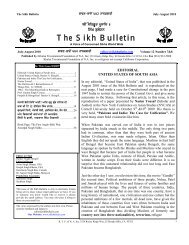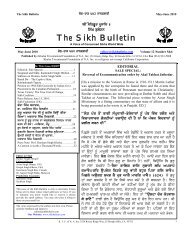You also want an ePaper? Increase the reach of your titles
YUMPU automatically turns print PDFs into web optimized ePapers that Google loves.
<strong>The</strong> <strong>Sikh</strong> <strong>Bulletin</strong> vYswK 537 April 2005<br />
<strong>The</strong>se are taboo questions. But they need to be faced for the<br />
survival of Guru Nanak’s message.<br />
1 page 3<br />
2 page 5<br />
3 page 7<br />
4 SB Feb 2005 p.21 .<br />
Hardev Singh Shergill<br />
*****<br />
AMRIT<br />
From <strong>The</strong> Encyclopaedia of <strong>Sikh</strong>ism<br />
AMRIT, derived from Sanskrit amrta, defined variously as<br />
not dead, immortal, imperishable; beautiful, beloved; world<br />
of immortality, heaven; immortality, eternity; final emancipation;<br />
nectar, ambrosia; nectar-like food; antidote against<br />
poison; or anything sweet, commonly means a liquid or<br />
drink by consuming which one attains everlasting life or<br />
immortality. It is in this sense that the word was first used in<br />
the Vedic hymns. According to Hindu mythology, amrit was<br />
extracted by the gods by churning the ocean with the<br />
assistance of the demons and it was by drinking it that the<br />
gods became immortal. A similar concept of an<br />
immortalizing drink also exists in Greek and Semitic<br />
mythologies wherein it is variously called ambrosia, nectar<br />
or ab-i-hayat. In the <strong>Sikh</strong> tradition, amrit is not some<br />
magical potion that would confer upon the consumer an<br />
unending span of life or bring about automatic release from<br />
the cycle of birth, death and rebirth. <strong>The</strong> term is however<br />
retained figuratively to signify what leads to such release. In<br />
this sense, amrit is not something external to man "but is<br />
within him and is received by God's grace" (GG, 1056,<br />
1238). In the holy hymns, amrit is repeatedly equated with<br />
nam, the Name, or Sabda, the Word (e.g. GG, 729,644,538,<br />
394). It is amrit of the True Name which when imbibed<br />
quenches and satiates all appetites (GG, 594).<br />
Amrit is also used in gurbani in the adjectival sense of<br />
sweet, delicious, good, sweet-sounding, etc. in phrases such<br />
as amritu bhojanu namu hari — God's Name is delicious<br />
food (GG, 556), amrit katha—dulcet discourse (GG, 255),<br />
amrit dristi— immortalizing glance (GG, 191), amrita pria<br />
bachan tuhare — sweet are Thy words, 0 Dear One (GG,<br />
534). Guru Amar Das in an astpadi (eight-stanza hymn) in<br />
Majh measure describes different characteristics of amrit<br />
such as eradicator of egoity, producer' of amrit effect, a<br />
means to liv (concentration,) and giver of happiness (GG,<br />
118-19).<br />
This amrit of God's Name is realized from within the self<br />
and can be realized at any hour of day or night, but the best<br />
time conducive to realization is the last quarter of night or<br />
the early morning to which Guru Nanak refers as amrit vela<br />
when the devotee may contemplate the greatness of God<br />
(CG, 2). Guru Arigad says that during early morning, the<br />
last quarter of night, the awakened ones develop a fondness<br />
for cultivating the True Name (GG, 146). Historically, amrit<br />
in the <strong>Sikh</strong> tradition refers to the baptismal water Guru<br />
Gobind Singh, Nanak X, consecrated for the initiatory rites<br />
promulgated in supersession of charan-amrit at the time of<br />
the creation of the Khalsa brotherhood. This is called<br />
Khande da Amrit or nectar touched with the double-edged<br />
sword. See PAHUL<br />
*****<br />
PAHUL<br />
From <strong>The</strong> Encyclopaedia of <strong>Sikh</strong>ism<br />
PAHUL or amrit sanskar, is the name given in the <strong>Sikh</strong><br />
tradition to the ceremony of initiation. <strong>The</strong> word Pahul is a<br />
derivative from a substantive, pahu—meaning an agent<br />
which brightens, accelerates or sharpens the potentialities of<br />
a given object. In the history of the <strong>Sikh</strong> faith, the initiation<br />
ceremony has passed through two distinct phases. From the<br />
time of Guru Nanak (1469-1539), the founder, up to 1699,<br />
charanamrit or pagpahul was the custom. Charanamrit and<br />
pagpahul meant initiation by water touched by the Master's<br />
toe—the charan and pag both being equivalents of the word<br />
'foot'. In early <strong>Sikh</strong>ism, the neophytes sipped water poured<br />
over the Guru's toe to be initiated into the fold. Where the<br />
Guru was not present, masands or local sangat leaders<br />
officiated. A reference to initiation by charanamrit occurs in<br />
Bhai Gurdas, Varan, 1.23, born 12 years after the passing<br />
away of Guru Nanak. <strong>The</strong> practice continued until 1699<br />
when, at the time of the inauguration of the Khalsa, Guru<br />
Gobind Singh introduced khande di pahul, i.e. pahul by<br />
khanda, the double-edged steel sword. This was done at<br />
Anandpur at the time of Baisakhi festival on 30 March<br />
1699, in a soul-stirring drama. At the morning assembly of<br />
the <strong>Sikh</strong>s drawn from all four corners of India, Guru Gobind<br />
Singh, sword in hand, proclaimed, "My sword wants today a<br />
head. Let any one of my <strong>Sikh</strong>s come forward. Isn't there a<br />
<strong>Sikh</strong> of mine who would be prepared to sacrifice his life for<br />
his Guru" To five similar calls successively made, five<br />
<strong>Sikh</strong>s offered their heads one after the other. <strong>The</strong>y were<br />
Daya Singh, Mohkam Singh, Sahib Singh, Dharam Singh<br />
and Himmat Singh. Guru Gobind Singh proceeded to hold<br />
the ceremony of initiation to mark their rebirth as new men.<br />
Filling an iron bowl with clean water, he kept stirring it with<br />
a two-edged sword while reciting over it five of the sacred<br />
texts, banis—-Japu,Jap, Savaiyye, Chaupai and Anand<br />
(stanzas 1-5, and 40). <strong>The</strong> Guru's wife, Mata jitoji<br />
(according to some, Mata Sahib Devan) poured into the<br />
vessel sugar crystals, mingling sweetness with the alchemy<br />
of iron. <strong>The</strong> five <strong>Sikh</strong>s sat on the ground around the bowl<br />
reverently as the holy water was being churned to the<br />
recitation of the sacred verses. With the recitation of the five<br />
banis completed, khande di pahul or amrit, the Nectar of<br />
Immortality, was ready for administration. Guru Gobind<br />
Singh gave the five <strong>Sikh</strong>s five palmsful each of it to drink.<br />
<strong>The</strong> disciple sat bir-asan, i.e. in the posture of a warrior<br />
with his left knee raised and the right knee touching the<br />
ground. Every time the Guru poured the nectar into his<br />
palms to drink, he called out aloud, "Bol Vahiguruji ka<br />
<strong>The</strong> <strong>Sikh</strong> Center Roseville, 201 Berkeley Ave, Roseville, CA. 95678 3
















